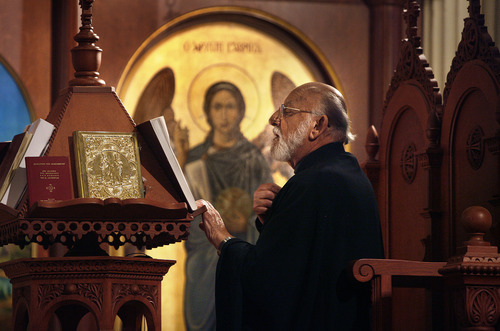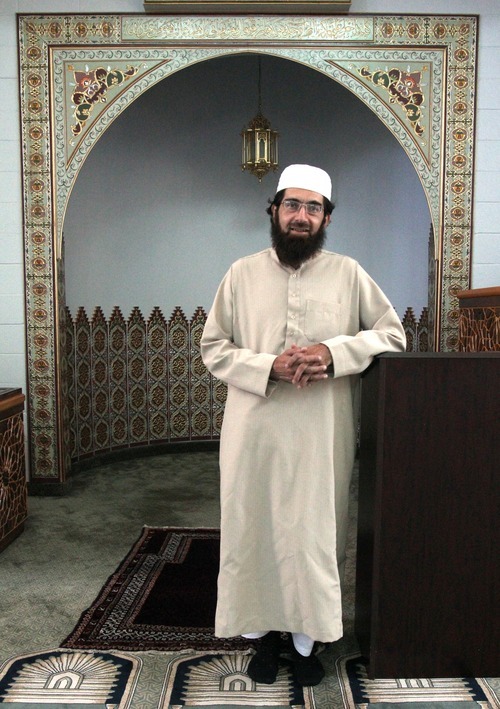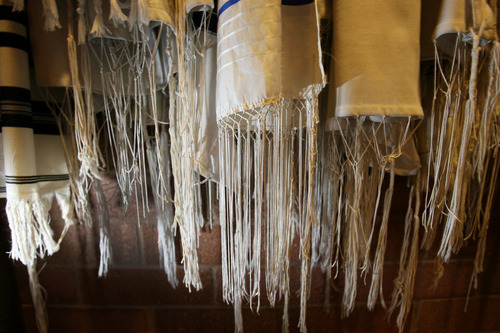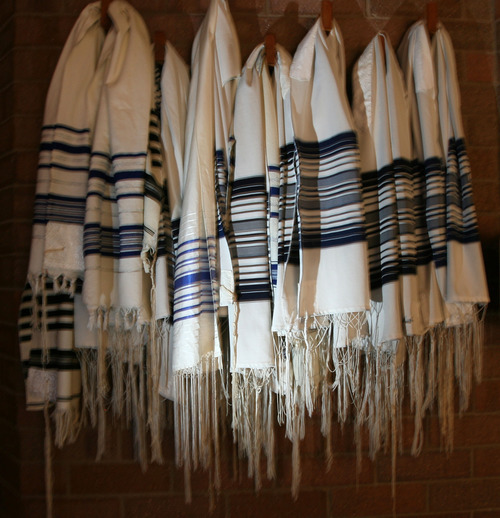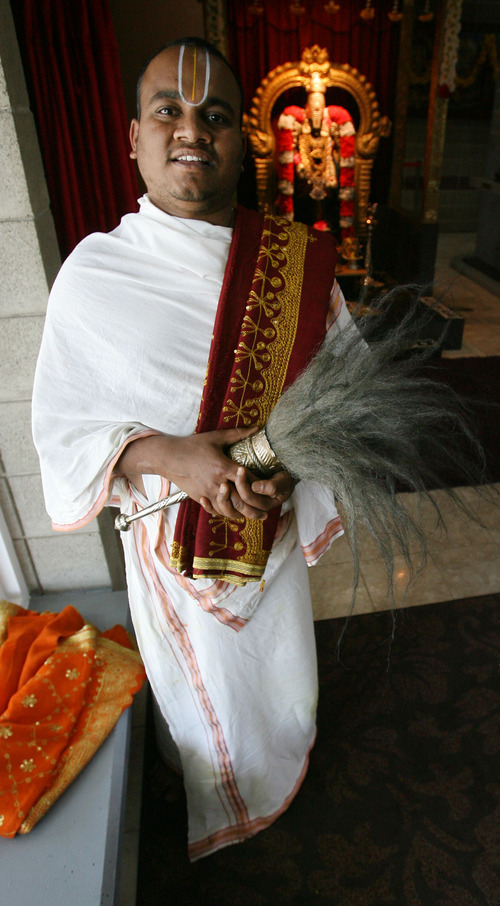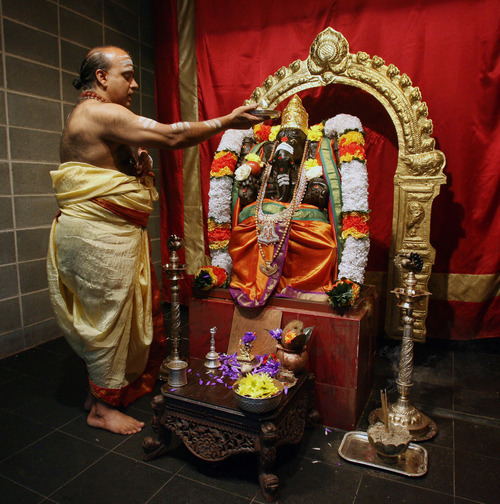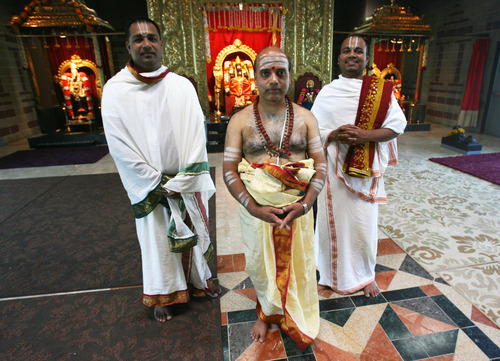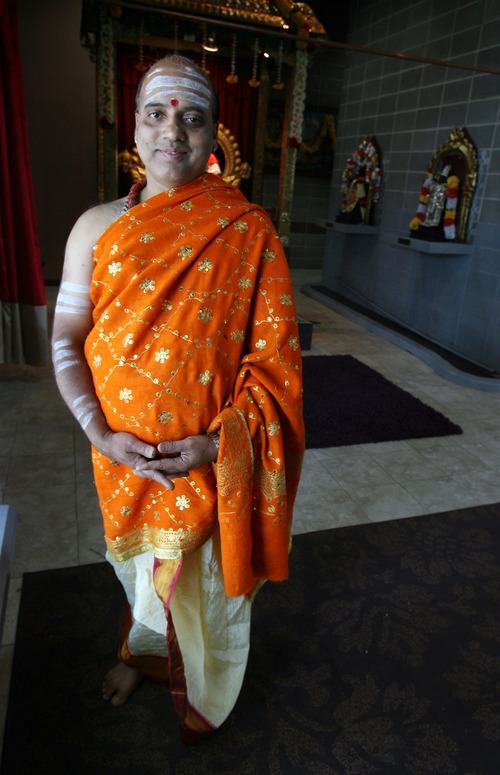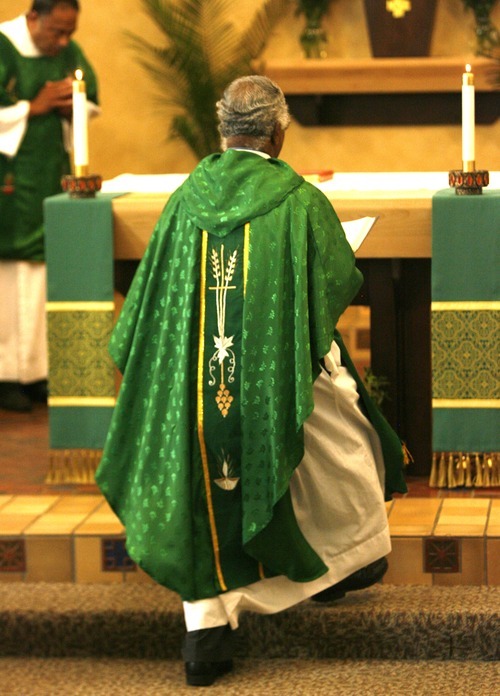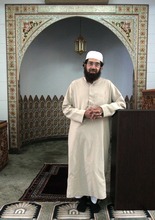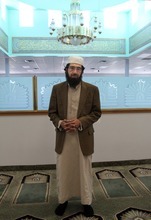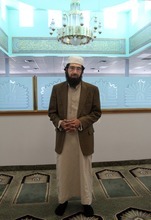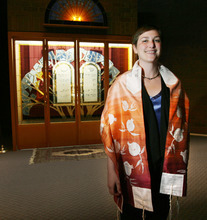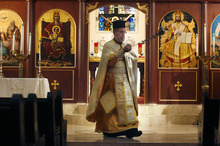This is an archived article that was published on sltrib.com in 2012, and information in the article may be outdated. It is provided only for personal research purposes and may not be reprinted.
Firefighters, police and doctors hold some of society's most important jobs — and they wear uniforms to set them apart.
In some ways, clergy are similar. They too shoulder heavy responsibilities: people's hearts and minds. To denote that designation, rabbis, priests, preachers and more wear specific clothes.
Their attire isn't just adornment. It often carries historical roots and, like the words and art faiths cherish, is laden with symbolic meaning.
The Salt Lake Tribune spoke with a handful of Utah faith leaders to find out what they wear and why.
Catholic priests
Two colors often come to mind when non-Catholics think of Catholic priests: black and white. For everyday business, priests often wear black clothes with white collars.
But churchgoing Catholics know priests have a colorful repertoire of religious garb, called vestments.
"It makes the liturgy really formal," said the Rev. Lourduraj Gally Gregory of St. Patrick Catholic Church in west Salt Lake City. "It's an act of the church."
During services, priests typically wear long robes, called chasubles. The colors change with the liturgical season. Priests wear purple or violet chasubles at the start of the liturgical year, during Advent, which takes place in late November and December. It's a time of penance, waiting and preparation, all of which purple symbolizes, Gally Gregory said.
Then, during Christmas, priests trade the purple vestments for white ones, meant to symbolize joy and purity for the holy season. Priests again don purple robes during Lent and switch back to white during Easter.
For the times between Christmas and Lent and between Easter and Advent, called Ordinary Time, they wear green. And for feasts of the martyrs and feasts of the apostles, priests wear red robes, symbolizing the blood shed for Jesus Christ, Gally Gregory said.
Priests wear chasubles over white robes called albs. And they wear stoles around their necks. Some also tie long ropes with tassels around their waists, symbolizing Jesus being tied to a pillar when he was scourged.
Vestments can vary from priest to priest, depending on the church, country and region. Gally Gregory, who hails from India, often wears robes covered in luminous gold stitching, made in his birth country. He was a priest in India for 17 years before coming to the United States to fill a need for clergy here.
Jewish rabbis
In movies and on TV, rabbis often are portrayed as bristle-bearded men with long curls framing their faces and broad, black hats. But that's true only of certain groups of Jews.
Rabbis in Conservative and Reform synagogues — groups with which most American Jews identify — dress differently.
"The truth of the matter is, for Jewish clergy, the attire is not significantly different than what someone in our congregation might wear," said Rabbi Ilana Schwartzman of Salt Lake City's Congregation Kol Ami. "As opposed to a lot of other religions, a rabbi is not singled out by God as necessarily having some sort of a calling or special mission, and while rabbis do different things during their day, we don't change our nature as people when we become a rabbi."
That means rabbis such as Schwartzman often look pretty much the same as their congregants during services.
Schwartzman typically wears a pantsuit during Friday night and Saturday morning services. During morning services, she also wears a tallit, which is a prayer shawl with tassels containing knots and strings that correspond to the number of commandments in the Torah. Congregants also often wear the prayer shawls during certain services.
"It's really a reminder of our fidelity to God," she said, "and to the commandments."
Male rabbis and male congregants typically cover their heads with a cap called a kippah or yarmulke as a sign of respect to God. Some female rabbis also cover their heads, though Schwartzman does not.
During the High Holidays, Yom Kippur and Rosh Hashana, Schwartzman wears a white robe partly to reflect the formality of those days.
Greek Orthodox priests
In America, many Greek Orthodox priests, like their Catholic counterparts, tend to wear black clothes and white collars when performing everyday religious duties.
"The reason it's been chosen in America is it's recognized throughout the states as someone being a clergyman," said the Rev. Matthew Gilbert of Holy Trinity Greek Orthodox Cathedral in Salt Lake City.
During services, however, priests go all out, wearing religious garments also called vestments.
"Many of the robes are similar to what the royalty wore during Byzantium," Gilbert said, referring to the Byzantine Empire, an offshoot of the Roman Empire, which persisted from about A.D. 300 to about 1400.
First, a priest puts on a long, inner robe, often white, called a sticharion, symbolic of purity, a spotless life and spiritual joy, according to the Manual of Instruction for Altar Servers, which Gilbert keeps in his office. Next, the priest puts on an epitrachelion, a long stole worn around the neck that drops down a priest's front, symbolizing power, grace and authority and the cross upon which Christ was carried and crucified. It's something the priest must wear whenever celebrating any service.
The priest ties a cloth belt called a zoni around the sticharion and epitrachelion, symbolizing strength given by God and the cord soldiers used to tie Christ's hands.
A Greek Orthodox priest also wears cuffs around his wrists, symbolizing the bonds tying the hands of Christ when he was scourged and reminding the wearer that God created everything with his hands and the priest should trust the Almighty.
Some priests also wear an epigonation, a cloth-covered board that hangs at the side of the body below the waist, held by a string around the neck. It symbolizes the towel Christ used when he washed the feet of his disciples. It's worn by priests who've received a special honor and title from the bishop, according to the manual.
Last, a priest wears an outer robe over the vestments called a felonion. The felonion, a reminder of righteousness, represents the seamless robe Christ wore during his trial and before his crucifixion.
The colors of the vestments vary by season.
Muslim imams
During services, Muslim religious leaders, called imams, often dress much like their worshippers: in loose attire.
"The rule is very simple," said Imam Muhammed Mehtar of the Islamic Society of Greater Salt Lake. "The clothing has to be modest. It has to cover your body in a manner in which an outsider cannot see its shape or figure of the body."
He said Muslims try to dress respectfully when in mosques — as if they were standing in a courtroom before a judge.
"God is the biggest and best of judges," Mehtar said.
As an imam, Mehtar tries to wear especially loose, conservative clothing. He said imams in America often don both traditional and American-style clothing, though he said he tries to wear traditional clothing as much as he can.
During services, he typically puts on a type of long tunic that drops past his knees called a thobe, though the name can vary by country. Sometimes, he said, imams also wear robes over the thobes in various colors.
Most imams also wear hats to show respect for God, and Muslims, as in other Eastern religions, take off their shoes when praying.
"The idea of shoes is to protect you from dirt," Mehtar said. "You never know where shoes have been, and, therefore, it is disrespectful to pray with something that could have a taint upon it."
Hindu priests
In Hinduism, priests often wear traditional white clothing, consisting of lower and upper garments, said Indra Neelameggham, a founder of the Sri Ganesha Hindu Temple of Utah in South Jordan.
It's attire that can vary by region. For example, priests from southern India may wear only a sort of scarf over their upper bodies because of the heat, whereas priests from northern India, where it's colder, may wear woven garments on their upper bodies. The lower garment traditionally consists of cloth draped around the body.
Hindu priests also place religious marks on their foreheads, denoting their denomination. For example, devotees of Shiva wear three horizontal ashen marks on their foreheads, whereas devotees of Vishnu may bear three vertical marks. Priests serving female deities are likely to wear red dots on their foreheads.
Hindu worshippers also eschew shoes when in their temples.
"Shoes may come into contact with all sorts of unclean stuff," Neelameggham said, "so you leave it outside the home when you enter the home, and the most sacred home is the home of God."
Twitter: @lschencker



